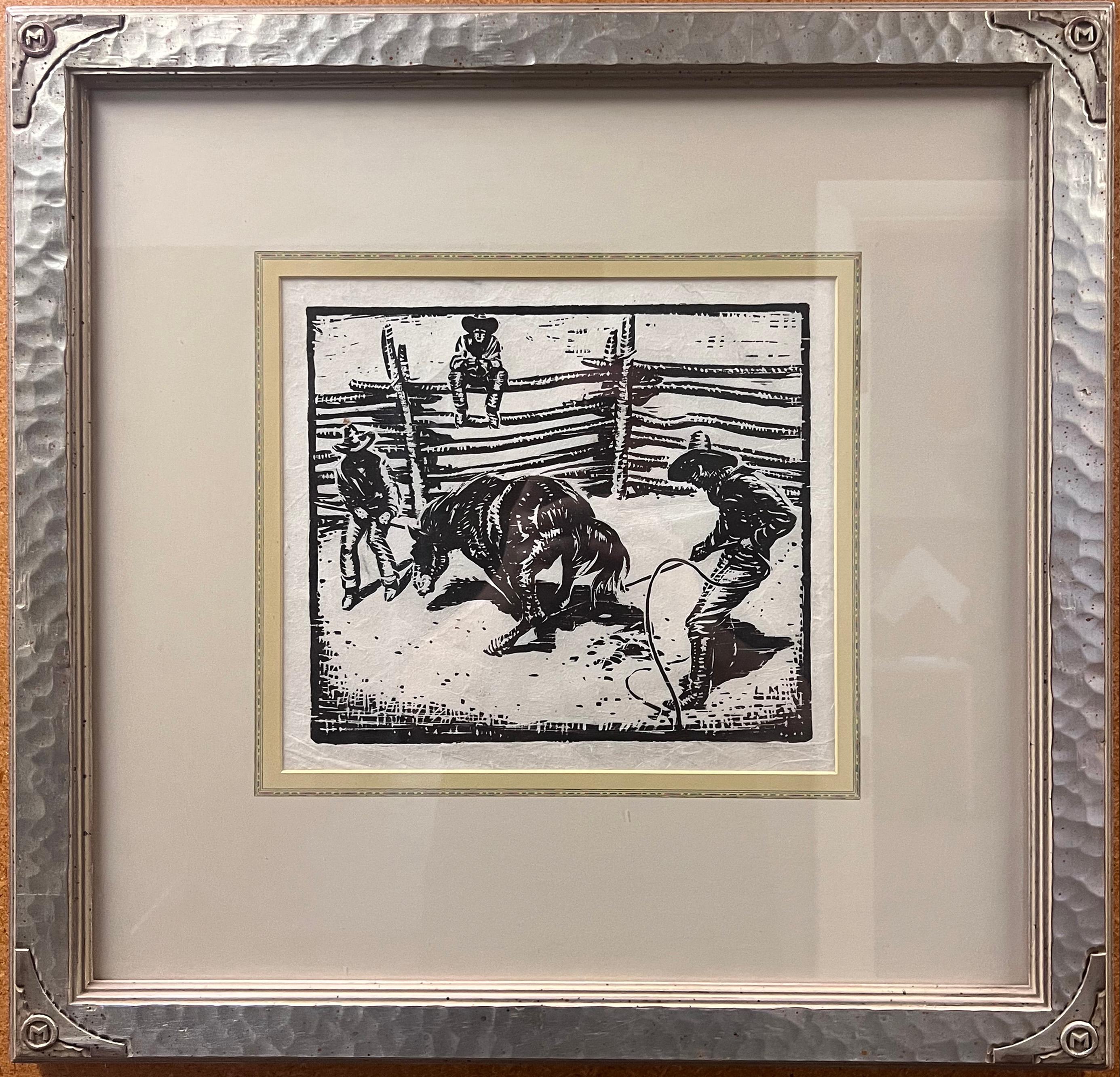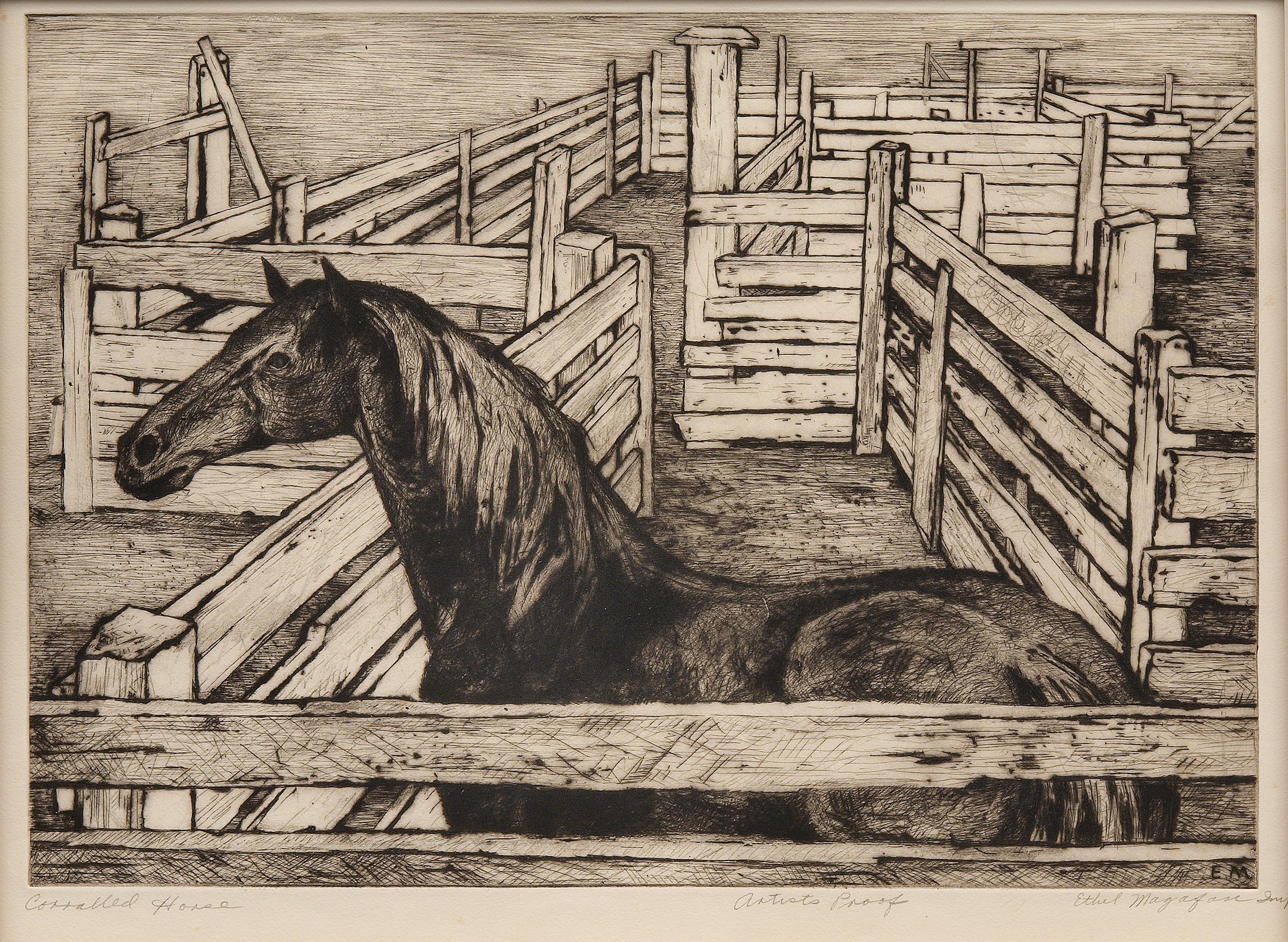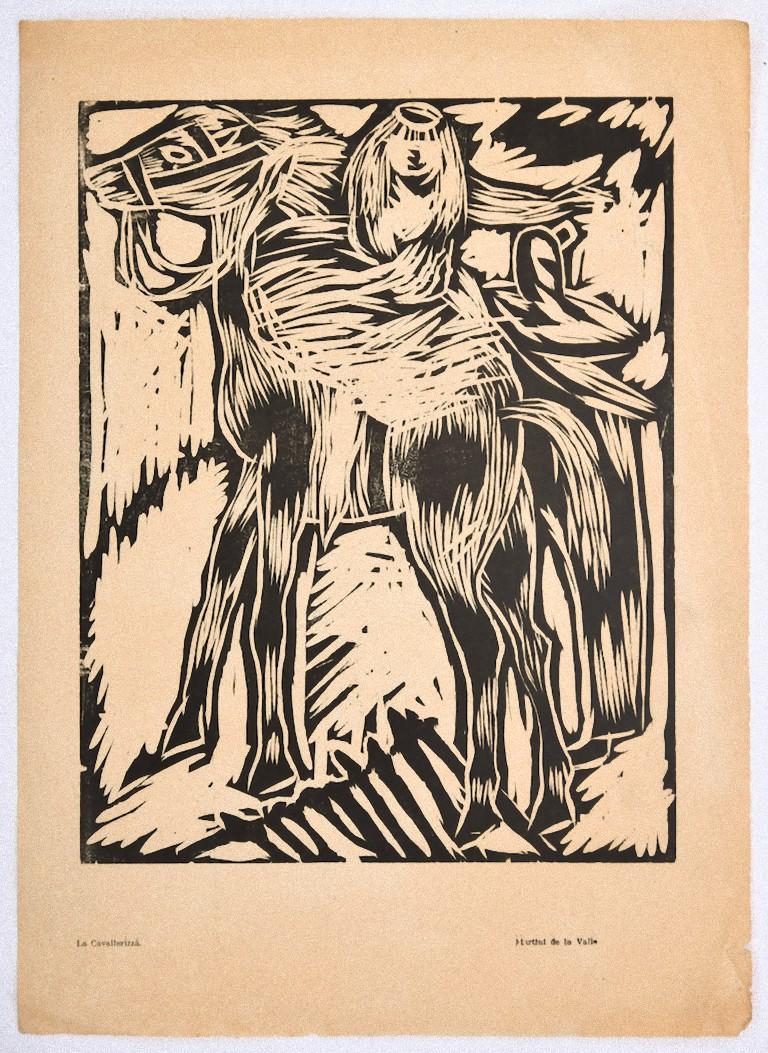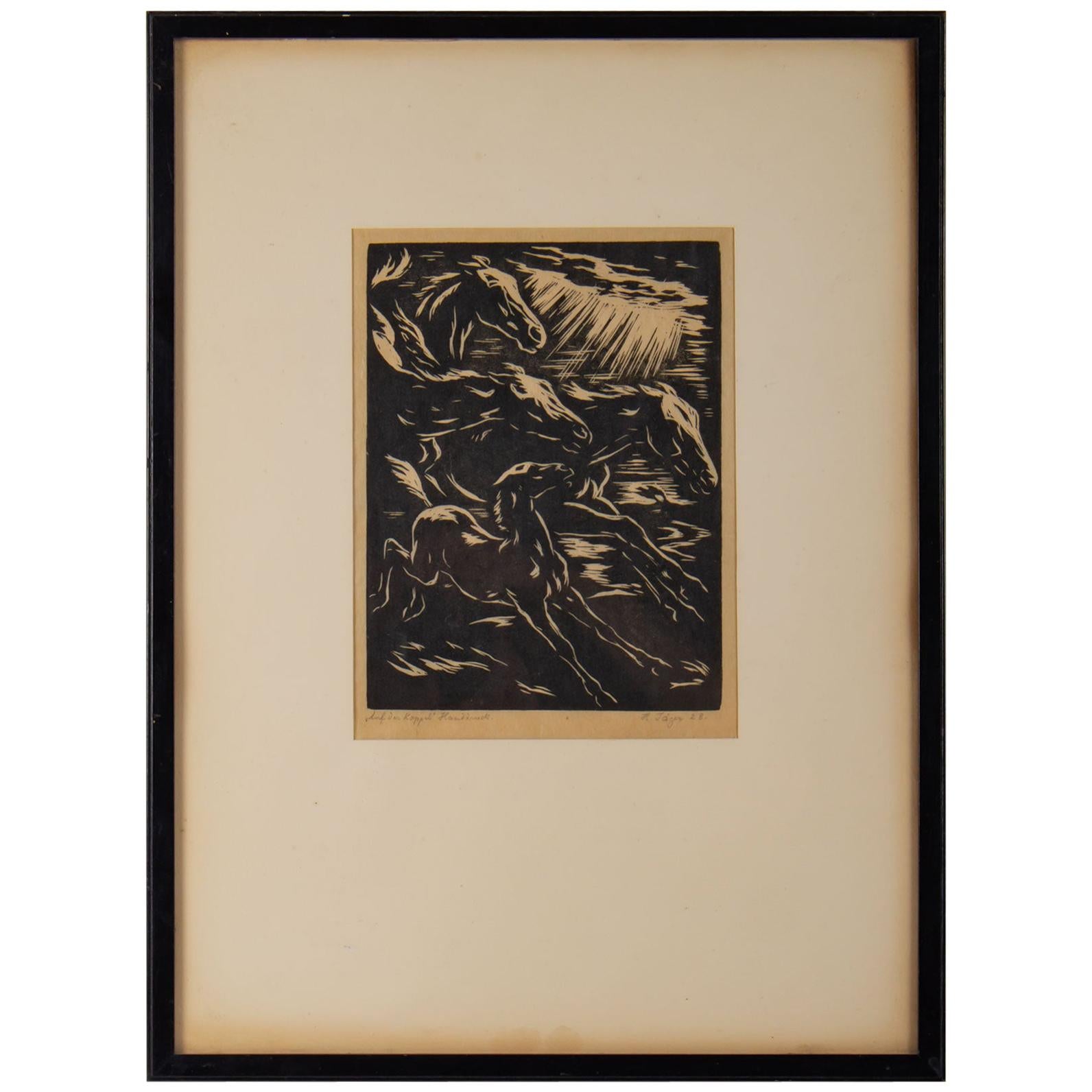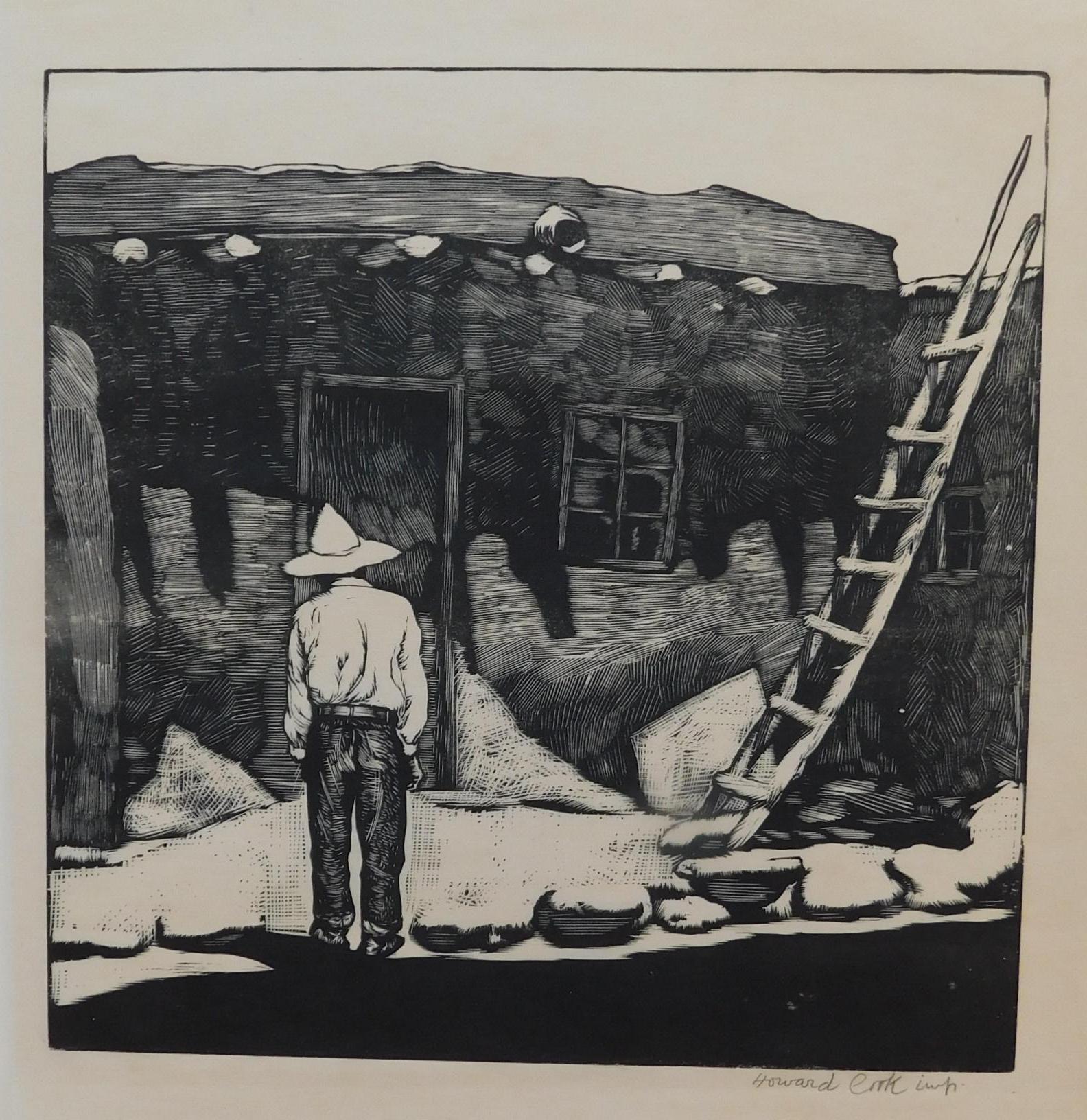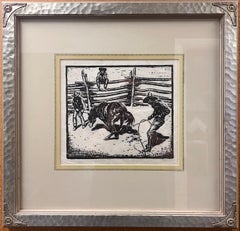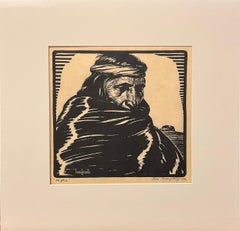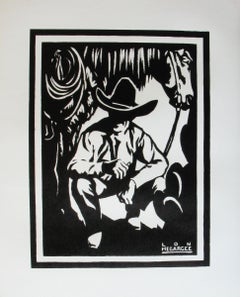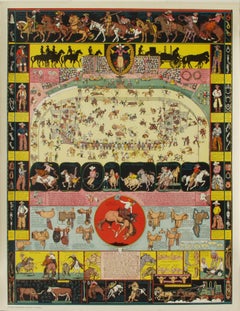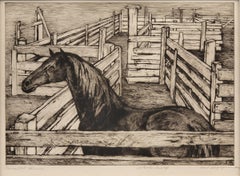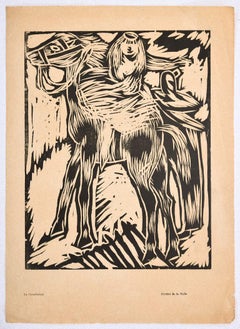Items Similar to Bronc by Lon Megargee, Woodblock Print ca. 1920s with Handmade Saguaro Rib Frame
Want more images or videos?
Request additional images or videos from the seller
1 of 2
Lon MegargeeBronc by Lon Megargee, Woodblock Print ca. 1920s with Handmade Saguaro Rib Frame1920s
1920s
$3,800
£2,948.77
€3,329.35
CA$5,437.45
A$5,933.25
CHF 3,069.67
MX$70,979.44
NOK 38,777.31
SEK 36,411.28
DKK 24,864.34
About the Item
SHIPPING CHARGES INCLUDE SHIPPING, PACKAGING & **INSURANCE**
Bronc by Lon Megargee, Woodblock Print ca. 1920s
Handmade Saguaro Rib Frame, double linen mat, museum archival materials
Bronc
Woodblock Print, signed in print
Image: 8 3/4 x 9 7/8 inches
Frame: 21 x 20 inches
SHIPPING CHARGES INCLUDES, SHIPPING, PACKAGING & INSURANCE
FINE ART ESTATE OF LON MEGARGEE
Megargee Custom Handmade Saguaro Frame
We offer signed in print and original signature block prints. Custom, hand carved, signature frames, with archival standards and a speciality in hand dyed mats and french matting are provided for a beautiful and timeless presentation.
Free shipping Continental US
Biography
Megargee explored different mediums; printmaking captivated him in particular. The contrast of the black and white block print method captured perfectly his interpretation of a bold American West. The first print was produced around 1921 and culminated with the creation of “The Cowboy Builds a Loop” in 1933 with 28 images and poetry by his friend, Roy George. Megargee continued producing prints throughout the 1940s and early 50s.
Creator of the iconic logo for the Stetson Hat Company, " Last Drop From his Stetson", still in use today.
Fine Art Estate of Lon Megargee
At age 13, Lon Megargee came to Phoenix in 1896 following the death of his father in Philadelphia. For several years he resided with relatives while working at an uncle’s dairy farm and at odd jobs. He returned to Philadelphia in 1898 – 1899 in order to attend drawing classes at the Pennsylvania Academy of the Fine Arts. Back in Phoenix in 1899, he decided at the age of 16 to try to make his living as a cowboy. Lon moved to the cow country of Wickenburg where he was hired by Tex Singleton’s Bull Ranch. He later joined the Three Bar Ranch . . . and, after a few years, was offered a job by Billy Cook of the T.T. Ranch near New River. By 1906, Megargee had learned his trade well enough to be made foreman of Cook’s outfit. Never shy about taking risks, Lon soon left Cook to try his own hand at ranching. He partnered with a cowpuncher buddy, Tom Cavness, to start the El Rancho Cinco Uno at New River. Unfortunately, the young partners could not foresee a three-year drought that would parch Arizona, costing them their stock and then their hard-earned ranch.
Breaking with his romantic vision of cowboy life, Megargee finally turned to art full time. He again enrolled at the Pennsylvania Academy and then the Los Angeles School of Art and Design during 1909 – 1910. The now well-trained student took his first trip to paint “en plein air” (outdoors) to the land of Hopi and Navajo peoples in northern Arizona. After entering paintings from this trip in the annual Territorial Fair at Phoenix, in 1911, he surprisingly sold his first oil painting to a major enterprise – the Santa Fe Railroad . . . Lon received $50 for “Navajos Watching the Santa Fe Train.” He soon sold the SFRR ten paintings over the next two years. For forty years the railroad was his most important client, purchasing its last painting from him in 1953.
In a major stroke of good fortune during his early plein-air period, Megargee had the opportunity to paint with premier artist, William R. Leigh (1866 – 1955). Leigh furnished needed tutoring and counseling, and his bright, impressionistic palette served to enhance the junior artist’s sense of color and paint application. In a remarkable display of unabashed confidence and personable salesmanship, Lon Megargee, at age 30, forever linked his name with Arizona art history. Despite the possibility of competition from better known and more senior artists, he persuaded Governor George Hunt and the Legislature in 1913 to approve 15 large, historic and iconic murals for the State Capitol Building in Phoenix. After completing the murals in 1914, he was paid the then princely sum of roughly $4000. His Arizona statehood commission would launch Lon to considerable prominence at a very early point in his art career.
Following a few years of art schooling in Los Angeles, and several stints as an art director with movie studios, including Paramount, Megargee turned in part to cover illustrations for popular Western story magazines in the 1920s.
In the 1920s, as well, Lon began making black and white prints of Western types and of genre scenes from woodblocks. These prints he generally signed and sold singly. In 1933, he published a limited edition, signed and hard-cover book (about 250 copies and today rare)containing a group of 28 woodblock images. Titled “The Cowboy Builds a Loop,” the prints are noteworthy for strong design, excellent draftsmanship, humanistic and narrative content, and quality. Subjects include Southwest Indians and cowboys, Hispanic men and women, cattle, horses, burros, pioneers, trappers, sheepherders, horse traders, squaw men and ranch polo players. Megargee had a very advanced design sense for simplicity and boldness which he demonstrated in how he used line and form. His strengths included outstanding gestural (action) art and strong figurative work. He was superb in design, originality and drawing, as a study of his prints in the Hays collection reveals.
In 1944, he published a second group of Western prints under the same title as the first. Reduced to 16 images from the original 28 subjects, and slightly smaller, Lon produced these prints in brown ink on a heavy, cream-colored stock. He designed a sturdy cardboard folio to hold each set. For the remainder of his life, Lon had success selling these portfolios to museum stores, art fairs and shows, and to the few galleries then selling Western art.
Drawing on real working and life experiences, Lon Megargee had a comprehensive knowledge, understanding and sensitivity for Southwestern subject matter. Noted American modernist, Lew Davis (1910 – 1979), helped to explain the uniqueness, strength and character of Megargee’s art in a 1975 interview with an Arizona publication: “His restless independence as a man and an artist was clear then (before WWI) and remained so until his death. Always one characteristic stood out. He was indigenous. He belonged here. Not a carpetbagger with a paint box, or a disillusioned urbanite seeking a new life, but an artist who used what he knew and had lived to put down what he had seen.”
From the origins of his career in art, Lon Megargee had a strong sense of the importance and worthiness of contributions that had been made by Native Americans and Hispanics. Even when satirizing their actions and foibles, and those of his Anglo peers, Megargee in his art provided a fairness and balance to all creeds that was enlightened for its time.
- Creator:Lon Megargee (1883 - 1960, American)
- Creation Year:1920s
- Dimensions:Height: 8.75 in (22.23 cm)Width: 19 in (48.26 cm)
- Medium:
- Period:
- Condition:
- Gallery Location:Phoenix, AZ
- Reference Number:1stDibs: LU2623215174502
About the Seller
No Reviews Yet
Vetted Professional Seller
Every seller passes strict standards for authenticity and reliability
1stDibs seller since 2023
8 sales on 1stDibs
- ShippingRetrieving quote...Shipping from: Phoenix, AZ
- Return Policy
More From This Seller
View AllThe Bronc by Lon Megargee
Located in Phoenix, AZ
Lon Megargee 1883-1960
"The Bronc"
Wood block print
Signed in plate, lower right
Image size: 9 x 10 inches
Frame size 21 x 21.5 inches
Creator of Stetson's hat logo "Last Drop from his Hat"
Lon Megargee
1883 - 1960
At age 13, Lon Megargee came to Phoenix in 1896 following the death of his father in Philadelphia. For several years he resided with relatives while working at an uncle’s dairy farm and at odd jobs. He returned to Philadelphia in 1898 – 1899 in order to attend drawing classes at the Pennsylvania Academy of the Fine Arts. Back in Phoenix in 1899, he decided at the age of 16 to try to make his living as a cowboy.
Lon moved to the cow country of Wickenburg, Arizona where he was hired by Tex Singleton’s Bull Ranch. He later joined the Three Bar R. . . and after a few years, was offered a job by Billy Cook of the T.T. Ranch near New River. By 1906, Megargee had learned his trade well enough to be made foreman of Cook’s outfit.
Never shy about taking risks, Lon soon left Cook to try his own hand at ranching. He partnered with a cowpuncher buddy, Tom Cavness, to start the El Rancho Cinco Uno at New River. Unfortunately, the young partners could not foresee a three-year drought that would parch Arizona, costing them their stock and then their hard-earned ranch.
Breaking with his romantic vision of cowboy life, Megargee finally turned to art full time. He again enrolled at the Pennsylvania Academy of Art and then the Los Angeles School of Art and Design during 1909 – 1910. The now well-trained student took his first trip to paint “en plein air” (outdoors) to the land of Hopi and Navajo peoples in northern Arizona. After entering paintings from this trip in the annual Territorial Fair at Phoenix, in 1911, he surprisingly sold his first oil painting to a major enterprise – the Santa Fe Railroad . . . Lon received $50 for “Navajos Watching the Santa Fe Train.” He soon sold the SFRR ten paintings over the next two years. For forty years the railroad was his most important client, purchasing its last painting from him in 1953.
In a major stroke of good fortune during his early plein-air period, Megargee had the opportunity to paint with premier artist, William R. Leigh (1866 – 1955). Leigh furnished needed tutoring and counseling, and his bright, impressionistic palette served to enhance the junior artist’s sense of color and paint application. In a remarkable display of unabashed confidence and personable salesmanship, Lon Megargee, at age 30, forever linked his name with Arizona art history. Despite the possibility of competition from better known and more senior artists, he persuaded Governor George Hunt and the Legislature in 1913 to approve 15 large, historic and iconic murals for the State Capitol Building in Phoenix. After completing the murals in 1914, he was paid the then princely sum of roughly $4000. His Arizona statehood commission would launch Lon to considerable prominence at a very early point in his art career.
Following a few years of art schooling in Los Angeles, and several stints as an art director with movie studios, including Paramount, Megargee turned in part to cover illustrations for popular Western story magazines in the 1920s.
In the 1920s, as well, Lon began making black and white prints of Western types and of genre scenes from woodblocks. These prints he generally signed and sold singly. In 1933, he published a limited edition, signed and hard-cover book (about 250 copies and today rare)containing a group of 28 woodblock images. Titled “The Cowboy Builds a Loop,” the prints are noteworthy for strong design, excellent draftsmanship, humanistic and narrative content, and quality. Subjects include Southwest Indians and cowboys, Hispanic men and women, cattle, horses, burros, pioneers, trappers, sheepherders, horse traders, squaw men and ranch polo players. Megargee had a very advanced design sense for simplicity and boldness which he demonstrated in how he used line and form. His strengths included outstanding gestural (action) art and strong figurative work. He was superb in design, originality and drawing, as a study of his prints in the Hays collection reveals.
In 1944, he published a second group of Western prints under the same title as the first. Reduced to 16 images from the original 28 subjects, and slightly smaller, Lon produced these prints in brown ink on a heavy, cream-colored stock. He designed a sturdy cardboard folio to hold each set. For the remainder of his life, Lon had success selling these portfolios to museum stores, art fairs and shows, and to the few galleries then selling Western art.
Drawing on real working and life experiences, Lon Megargee had a comprehensive knowledge, understanding and sensitivity for Southwestern subject matter. Noted American modernist, Lew Davis...
Category
Early 20th Century American Impressionist Figurative Prints
Materials
Woodcut
Hopi by Lon Megargee, Original Signed Block Print ca. 1920s
Located in Phoenix, AZ
Title: Hopi ca. 1920s
Artist: Lon Megargee
Medium: Block Print
Size: 11 x 11 inches (Sight Measurement)
SHIPPING CHARGES INCLUDE SHIPPING, PACKAGING & INSURANCE
Creator of Stetson's hat logo "Last Drop from his Hat"
Image of Lon Megargee not included in purchase.
Lon Megargee
1883 - 1960
At age 13, Lon Megargee came to Phoenix in 1896 following the death of his father in Philadelphia. For several years he resided with relatives while working at an uncle’s dairy farm and at odd jobs. He returned to Philadelphia in 1898 – 1899 in order to attend drawing classes at the Pennsylvania Academy of the Fine Arts. Back in Phoenix in 1899, he decided at the age of 16 to try to make his living as a cowboy.
Lon moved to the cow country of Wickenburg, Arizona where he was hired by Tex Singleton’s Bull Ranch. He later joined the Three Bar R. . . and after a few years, was offered a job by Billy Cook of the T.T. Ranch near New River. By 1906, Megargee had learned his trade well enough to be made foreman of Cook’s outfit.
Never shy about taking risks, Lon soon left Cook to try his own hand at ranching. He partnered with a cowpuncher buddy, Tom Cavness, to start the El Rancho Cinco Uno at New River. Unfortunately, the young partners could not foresee a three-year drought that would parch Arizona, costing them their stock and then their hard-earned ranch.
Breaking with his romantic vision of cowboy life, Megargee finally turned to art full time. He again enrolled at the Pennsylvania Academy of Art and then the Los Angeles School of Art and Design during 1909 – 1910. The now well-trained student took his first trip to paint “en plein air” (outdoors) to the land of Hopi and Navajo peoples in northern Arizona. After entering paintings from this trip in the annual Territorial Fair at Phoenix, in 1911, he surprisingly sold his first oil painting to a major enterprise – the Santa Fe Railroad . . . Lon received $50 for “Navajos Watching the Santa Fe Train.” He soon sold the SFRR ten paintings over the next two years. For forty years the railroad was his most important client, purchasing its last painting from him in 1953.
In a major stroke of good fortune during his early plein-air period, Megargee had the opportunity to paint with premier artist, William R. Leigh (1866 – 1955). Leigh furnished needed tutoring and counseling, and his bright, impressionistic palette served to enhance the junior artist’s sense of color and paint application. In a remarkable display of unabashed confidence and personable salesmanship, Lon Megargee, at age 30, forever linked his name with Arizona art history. Despite the possibility of competition from better known and more senior artists, he persuaded Governor George Hunt and the Legislature in 1913 to approve 15 large, historic and iconic murals for the State Capitol Building in Phoenix. After completing the murals in 1914, he was paid the then princely sum of roughly $4000. His Arizona statehood commission would launch Lon to considerable prominence at a very early point in his art career.
Following a few years of art schooling in Los Angeles, and several stints as an art director with movie studios, including Paramount, Megargee turned in part to cover illustrations for popular Western story magazines in the 1920s.
In the 1920s, as well, Lon began making black and white prints of Western types and of genre scenes from woodblocks. These prints he generally signed and sold singly. In 1933, he published a limited edition, signed and hard-cover book (about 250 copies and today rare)containing a group of 28 woodblock images. Titled “The Cowboy Builds a Loop,” the prints are noteworthy for strong design, excellent draftsmanship, humanistic and narrative content, and quality. Subjects include Southwest Indians and cowboys, Hispanic men and women, cattle, horses, burros, pioneers, trappers, sheepherders, horse traders, squaw men and ranch polo players. Megargee had a very advanced design sense for simplicity and boldness which he demonstrated in how he used line and form. His strengths included outstanding gestural (action) art and strong figurative work. He was superb in design, originality and drawing, as a study of his prints in the Hays collection reveals.
In 1944, he published a second group of Western prints under the same title as the first. Reduced to 16 images from the original 28 subjects, and slightly smaller, Lon produced these prints in brown ink on a heavy, cream-colored stock. He designed a sturdy cardboard folio to hold each set. For the remainder of his life, Lon had success selling these portfolios to museum stores, art fairs and shows, and to the few galleries then selling Western art.
Drawing on real working and life experiences, Lon Megargee had a comprehensive knowledge, understanding and sensitivity for Southwestern subject matter. Noted American modernist, Lew Davis...
Category
1920s American Impressionist Figurative Prints
Materials
Woodcut
Longhorns by Lon Megargee
Located in Phoenix, AZ
Lon Megargee 1883-1960
"Self Portrait"
Wood block print
Signed in plate, lower right
Image size: 15.63 x 12 inches
Frame size xx x xx inches
Creator of S...
Category
1930s American Impressionist Animal Prints
Materials
Screen
Jo Mora, Evolution of the Cowboy 1933, from Jo Mora Estate
Located in Phoenix, AZ
"LAST ONE IN MINT CONDITION"
Evolution of the Cowboy, 1933
Original Lithograph
Excellent condition, came directly from Jo Mora Jr.
Unframed!!
SHIPPING CHARGES INCLUDE SHIPPING, PACKAGING & INSURANCE
Original version was called Evolution of the Cowboy, 1933 or referred today as "Sweetheart of the Rodeo", Images from the poster were used for "Sweetheart of the Rodeo", the sixth album by American rock band the Byrds and was released on August 30, 1968. It was hated when released, today it is considered one of the great classics.
This is an original lithograph from the Jo Mora Estate from Jo Mora Jr.
Joseph Jacinto Mora (October 22, 1876 – October 10, 1947) was a Uruguayan-born American cowboy, photographer, artist, cartoonist, illustrator, painter, muralist, sculptor, and historian who wrote about his experiences in California. He has been called the "Renaissance Man of the West".
Early life
Mora was born on October 22, 1876, in Montevideo, Uruguay. His father was the Catalan sculptor, Domingo Mora, and his mother was Laura Gaillard Mora, an intellectual born in the Bordeaux region of France. His elder brother was F. Luis Mora, who would become an artist and the first Hispanic member of the National Academy of Design. The family entered the United States in 1880 and first settled in New York City, and then Perth Amboy, New Jersey.
Jo Mora 1931 Yosemite map
Jo Mora studied art at the Art Students League of New York and the Cowles Art School in Boston. He also studied with William Merritt Chase. He worked as a cartoonist for the Boston Evening Traveller, and later, the Boston Herald.
In the spring of 1903, Mora arrived in Solvang, California. He stayed at the Donohue Ranch. He made plans to travel to the Southwest to paint and photograph the Hopi. He spent time at the Mission Santa Inés; those photographs are now maintained by the Smithsonian Institution. Mora visited many Spanish missions in California that summer by horseback. He followed the "Mission Trail", also called the "Kings Highway".
In 1904, Mora visited Yosemite. Later, in 1904, to 1906, visited Arizona where he took photographs, painted and otherwise recorded the daily life of these Native Americans. Because the Hopi and other tribes have voiced their concerns more recently about photographs depicting religious ceremonies, the tribal nation should be contacted before they are used. He learned the Native languages and made detailed drawings of what he observed.
Career
In 1907, Mora wrote and illustrated the comic strip Animaldom.
In 1907, Mora returned to California and married Grace Needham. Their son, Joseph Needham Mora, was born on March 8, 1908. The Moras moved to San Jose, California, where Mora continued his work.
On 22 February 1911, the Native Sons of the Golden West Building, in San Francisco, with six terra cotta panels, by Domingo Mora and his son, Jo Mora, was dedicated.
In 1915, he served on the International Jury of Awards at the Panama–Pacific International Exposition and displayed six sculptures.[9]
In 1915-16 two of his sculptural commissions were revealed: the bronze memorial tablet with the profile of the late Archbishop Patrick W. Riordan for the Knights of Columbus and the Cervantes Monument in San Francisco's Golden Gate Park.[10][11] By 1919, he was sculpting for the Bohemian Club, including the Bret Harte Memorial plaque, completed in August 1919 and mounted on the outside of the private men's club building in San Francisco.
Carmel-by-the-Sea
In 1921, the Mora family relocated to Carmel-by-the-Sea, California, the largest art colony on the West Coast, making it their primary residence. He constructed a Craftsman-style home, which is located on the west side of San Carlos Street, the third house south of 1st Avenue.
Mora received a commission for the bronze and travertine Cenotaph, for Father Junípero Serra in the Memorial Chapel at the west end of Mission Carmel.
Mora was a director of the Carmel Art Association as early as 1934. His sculptures were exhibited between 1927 and 1934 in various galleries in Carmel.
Jo Mora is a serious sculptor, a responsible amateur actor; when mixed up with pen and ink, a humorist! Comic strips was once his trade. He was famous at it. That was years ago but his art of cartooning bloomed again when in recent years he produced the well known Mora Map of the Monterey Peninsula. Most successful with bronze statue creations which decorate many gardens in East and West. If he has a specialty in figures it is cowboys. He knows his West. Jo Mora will ever be famed for his portrayal of Pancho Lopez, The Bad Man, at Carmel Playhouse. He does everything well and is handsome while doing it. He is happily married-alas!
— Carmel Pine Cone
During the Great Depression, Mora created the "Carmel Dollar" as part of Carmel's program, offering unemployed residents scrip for public service, exchangeable for groceries and essentials; a three-cent stamp on the certificate's back acknowledged their efforts. When full, merchants accepted the certified scrip for goods or a dollar.
Architect Robert Stanton...
Category
1930s Other Art Style More Prints
Materials
Lithograph
High Wide and Handsome by Fletcher Martin 1953, Original Stone Lithograph
By Fletcher Martin
Located in Phoenix, AZ
SHIPPING CHARGES INCLUDE SHIPPING, PACKAGING & **INSURANCE**
Fletcher Martin
Size: 16 x12 inches
Stone lithograph
Frame 25 x 21 inches
High, Wide and Handsome- - 1953, Lithograph....
Category
1950s Contemporary Figurative Prints
Materials
Lithograph
Siesta by Lon Megargee 1929, Archival Pigmrnt Print
Located in Phoenix, AZ
Tequila Siesta
Lon Megargee
Archival Pigment Print
100% 300 gram cotton rag paper
Size: 22.5 x 27 inches
Paper size: 24 x 28.5 inches
Creator of the iconic logo for the Stetson Hat Company, " Last Drop From his Stetson", still in use today.
Fine Art Estate of Lon Megargee
At age 13, Lon Megargee came to Phoenix in 1896 following the death of his father in Philadelphia. For several years he resided with relatives while working at an uncle’s dairy farm and at odd jobs. He returned to Philadelphia in 1898 – 1899 in order to attend drawing classes at the Pennsylvania Academy of the Fine Arts. Back in Phoenix in 1899, he decided at the age of 16 to try to make his living as a cowboy. Lon moved to the cow country of Wickenburg where he was hired by Tex Singleton’s Bull Ranch. He later joined the Three Bar Ranch . . . and, after a few years, was offered a job by Billy Cook...
Category
1920s Figurative Prints
Materials
Archival Pigment
You May Also Like
Ethel Magafan “Corralled Horse” 1940s WPA-Era Modernist Etching, Artist’s Proof
By Ethel Magafan
Located in Denver, CO
Corralled Horse is a rare WPA-era modernist etching by acclaimed American artist Ethel Magafan, created in the 1940s. This artist’s proof depicts a lone dark horse within a wooden co...
Category
1940s American Modern Figurative Prints
Materials
Etching
Horsewoman - Original Woodcut Print by Arturo Martini - Early 20th Century
By Arturo Martini
Located in Roma, IT
Horsewoman is a woodcut print on ivory-colored, realized at the beginning of the XX century by the Italian artist Arturo Martini (Treviso, 1889 - Milan, 1947).
On the lower margin, the printed inscriptions with the title and the author: "La cavallerizza / Martini de la Valle...
Category
Early 20th Century Figurative Prints
Materials
Woodcut
"Roy Matthews Calf Roping" Famous 1930s/40s Rodeo Rider
Located in San Antonio, TX
Pepper Brown
(1926-1999)
Alpine Artist
Image Size: 9 x 13
Frame Size: 15 x 18.75
Medium: Ink Drawing
Dated 1942
"Roy Matthews Calf Roping"
Category
1940s Impressionist Animal Drawings and Watercolors
Materials
Ink
Engraving, Signed, 1928, Representative Stylized Horses Running, Framed
Located in Saint-Ouen, FR
Engraving, Signed, 1928, representative stylized horses running, framed
Measures: Frame H 46cm, W 34cm, W 1cm
Engraving H 22cm, W 16cm.
Category
Early 20th Century French Art Deco Prints
Materials
Paper
Howard Cook Taos Artist Original Woodcut, 1927 - Hopi House
By Howard Norton Cook
Located in Phoenix, AZ
Taos Artist Howard Cook original woodcut print, 1927.
Title: “Hopi House.” Duffy #47. Signed in pencil lower right.
Image size: 8"h x 8"w. Paper size: 10 x 8 3/4. Mat size: 20 x 16....
Category
Mid-20th Century Landscape Prints
Materials
Paper, Ink
Knight - Original Woodcut Print by Amadore Porcella - Early 20th Century
By Amadore Porcella
Located in Roma, IT
Knight is an original woodcut print realized by Amadore Porcella .
The state of preservation of the artwork is very good.
Passepartout dimension: ...
Category
Early 19th Century Modern Figurative Prints
Materials
Woodcut
More Ways To Browse
Antique Block Print
Antique Movie
Antique Book Covers
La Petite Corrida
Leon Boullet
Leroy Neiman Posters
Lithograph By Mirror
Lithograph Picasso 1957
Make Art Not War
Marc Chagall Poster Framed
Marc Chagall The Lovers
Marino Marini Shakespeare
Mary Cassatt Etchings
Matisse Signed Print
Max Baer
Max Beckmann Drypoint
May Belfort
Melanie Taylor Kent
